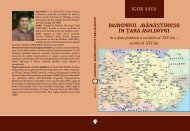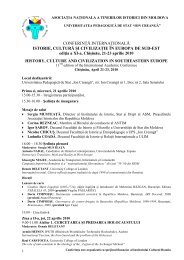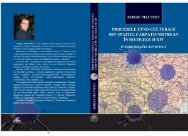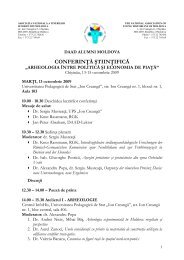Publicatie cu continut integral - Asociatia Tinerilor Istorici din Moldova
Publicatie cu continut integral - Asociatia Tinerilor Istorici din Moldova
Publicatie cu continut integral - Asociatia Tinerilor Istorici din Moldova
You also want an ePaper? Increase the reach of your titles
YUMPU automatically turns print PDFs into web optimized ePapers that Google loves.
ecenZıe<br />
larry WolFF. inventing eastern europe. The Map of Civilization on the Mind of the enlightenment.<br />
stanford university press, 1 .<br />
Recently translated into Romanian 1 and Russian 2 , the Wolff’s book is an outstan<strong>din</strong>g work in the field of<br />
intellectual history, which joints to several other very famous studies, dedicated to the research of intellectual<br />
constructions as a historical and <strong>cu</strong>ltural process (B.Anderson, Ed.Said, M.Todorova). In a very skillful and<br />
impressive manner, author shows how was created one of the strongest intellectual creation existent today – the<br />
concept of Eastern Europe.<br />
Recognizing that many people assume that it is the “iron <strong>cu</strong>rtain”, which provoked the division of the Europe,<br />
Wolff argues that the persistent alienation between Western and Eastern Europe is not only an outcome of the Cold<br />
War, or a fact of “economic disparity”, but represents the existence of the previous “<strong>cu</strong>ltural prejudice” (3). The<br />
author analyze various writings from the period of Enlightenment – classic works, memoirs, essays - produced<br />
by Western travelers and philosophers in 18 th Century, and demonstrates that “ it was the Western Europe that<br />
invented Eastern Europe as its complementary other half…” (4).<br />
Applying the pattern of imaginative construction offered by Edward Said’s Orientalism, Wolff shows that<br />
the concept of Eastern Europe was summarized as a realm “between Europe and Asia, between civilization<br />
and barbarism, domain of fantasy and adventure” (112); as an idea which “possessed both geographical and<br />
philosophical components” (359). Carefully dissecting and confronting numerous works of the Enlightenment era,<br />
Wolff proves that the work of inventing Eastern Europe consisted especially from associations and comparisons,<br />
“which drew upon both fact and fiction” and combination of “diverse domain of lands and people” (356).<br />
In general, the mental creation of the Eastern Europe in 18 th Century strikes as a <strong>cu</strong>mulative process of different<br />
negative stereotypes about these lands: backwardness (19), despotism (58), slavery (88), and places were existed<br />
people “to be beaten, even wanted to be beaten” (73), people “made to be subjugated” (260), “millions of cattle<br />
in human form, who are …utterly excluded from all privileges of mankind” (338); all of these as an antipode to<br />
West. This language is present in almost every operation of the process of discovering (or inventing): entering,<br />
mapping, addressing or peopling Eastern Europe.<br />
Nevertheless, many of the philosophers of the Enlightenment considered that Eastern Europe was in its<br />
progression to civilization, so they tried to recommend special “plan of civilization”. In parti<strong>cu</strong>lar, Russia and<br />
Poland were considered “the alternative laboratory of ideological experiment” (236), because of the receptiveness<br />
of their monarchs to the ideas of Enlightenment. In this sense, Voltaire’s Eastern Europe appears in need for<br />
discipline and domination (100), and he became an advocate of the idea of enlightened absolutism, as a univocal<br />
force applicable to the backward lands and peoples. (211). Diderot also brought concrete recommendations<br />
(three), but he as other enlighteners, had to face with bitterness the reluctance of Eastern Europe, and the argument<br />
that some great principles “would make beautiful books and bad works” (230).<br />
On the other hand, author emphasizes that the integration of knowledge and stereotypes, domination and<br />
subor<strong>din</strong>ation by the “eighteen-century experts” of the concept of Eastern Europe, pointed to “the way to conquest<br />
and domination” of Eastern Europe by Western Europe (8).<br />
One attentive reader will indicate that the Wolff’s work pictures not only the object of invention, but also the<br />
profile of the inventor. The later appears not clear enough, but still as a: <strong>cu</strong>rious, superficial; ready to experience<br />
the hidden fantasies in these lands; and whose “inseparable ideals of comfort and civilization always conditioned<br />
the confident superiority of the traveler in Eastern Europe” (123).<br />
However, I consider that a more complex analysis could be done in revealing the role of the subject in this<br />
parti<strong>cu</strong>lar context. The reason for elaborating this dimension is that it would help the reader to better understand<br />
and explain why appeared this specific image and not other of the Eastern Europe? It would reinforce the<br />
1 Larry Wolff. inventarea europei de est. Bu<strong>cu</strong>reşti: şti: : Humanitas, 2000.<br />
2 Larry Wolff. izobretaja Vostočnuju evropu: Karta civilizacij v soznanii epokhi Prosveščenija. Moskva: Historia Rossica, Novoe Litera-<br />
turnoe Obozrenie, 2003.<br />
Analele ANTIM. Revistă de istorie, 8, 2008, p. 276-277<br />
– –
















